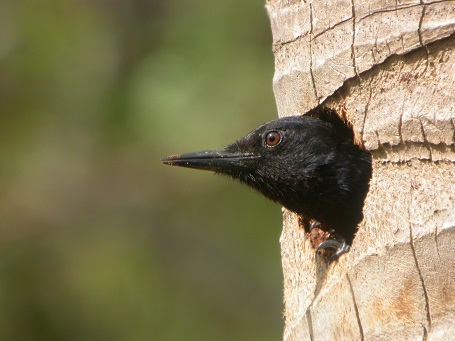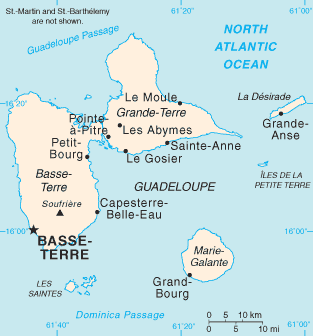|
Guadeloupe Woodpecker
The Guadeloupe woodpecker (''Melanerpes herminieri'') or Tapeur is a species of bird in the woodpecker family Picidae belonging to the genus ''Melanerpes.'' Endemic to the Guadeloupe archipelago in the Lesser Antilles, it is a medium-sized forest woodpecker with entirely black plumage and red-to-purple reflections on its stomach. It lives mainly in the islands' tropical rainforest areas. The woodpecker has no sexual dimorphism. The species has adapted under the pressure of urbanization to more open forest environments. During the breeding season, the Guadeloupe woodpecker is solitary bird that nests in holes it digs with its in the trunk of dead trees—mainly coconut—where the female lays three to five eggs. The eggs are incubated for fifteen days before hatching, after which the adult female feeds the chicks in the nest for about a month. Juvenile birds stay with the parents for several months before becoming independent. Guadeloupe woodpeckers are mainly insectivorous, bu ... [...More Info...] [...Related Items...] OR: [Wikipedia] [Google] [Baidu] |
Black Rats
The black rat (''Rattus rattus''), also known as the roof rat, ship rat, or house rat, is a common long-tailed rodent of the stereotypical rat genus ''Rattus'', in the subfamily Murinae. It likely originated in the Indian subcontinent, but is now found worldwide. The black rat is black to light brown in colour with a lighter underside. It is a generalist omnivore and a serious pest to farmers because it feeds on a wide range of agricultural crops. It is sometimes kept as a pet. In parts of India, it is considered sacred and respected in the Karni Mata Temple in Deshnoke. Taxonomy ''Mus rattus'' was the scientific name proposed by Carl Linnaeus in 1758 for the black rat. Three subspecies were once recognized, but today are considered invalid and are now known to be actually color morphs: *''Rattus rattus rattus'' – roof rat *''Rattus rattus alexandrinus'' – Alexandrine rat *''Rattus rattus frugivorus'' – fruit rat Characteristics A typical adult black rat is long, n ... [...More Info...] [...Related Items...] OR: [Wikipedia] [Google] [Baidu] |
Pleistocene
The Pleistocene ( , often referred to as the ''Ice age'') is the geological Epoch (geology), epoch that lasted from about 2,580,000 to 11,700 years ago, spanning the Earth's most recent period of repeated glaciations. Before a change was finally confirmed in 2009 by the International Union of Geological Sciences, the cutoff of the Pleistocene and the preceding Pliocene was regarded as being 1.806 million years Before Present (BP). Publications from earlier years may use either definition of the period. The end of the Pleistocene corresponds with the end of the last glacial period and also with the end of the Paleolithic age used in archaeology. The name is a combination of Ancient Greek grc, label=none, πλεῖστος, pleīstos, most and grc, label=none, καινός, kainós (latinized as ), 'new'. At the end of the preceding Pliocene, the previously isolated North and South American continents were joined by the Isthmus of Panama, causing Great American Interchang ... [...More Info...] [...Related Items...] OR: [Wikipedia] [Google] [Baidu] |
Handbook Of The Birds Of The World
The ''Handbook of the Birds of the World'' (HBW) is a multi-volume series produced by the Spanish publishing house Lynx Edicions in partnership with BirdLife International. It is the first handbook to cover every known living species of bird. The series was edited by Josep del Hoyo, Andrew Elliott, Jordi Sargatal and David A. Christie. All 16 volumes have been published. For the first time an animal class will have all the species illustrated and treated in detail in a single work. This has not been done before for any other group in the animal kingdom. Material in each volume is grouped first by family, with an introductory article on each family; this is followed by individual species accounts (taxonomy, subspecies and distribution, descriptive notes, habitat, food and feeding, breeding, movements, status and conservation, bibliography). In addition, all volumes except the first and second contain an essay on a particular ornithological theme. More than 200 renowned speci ... [...More Info...] [...Related Items...] OR: [Wikipedia] [Google] [Baidu] |
Monotypic Taxon
In biology, a monotypic taxon is a taxonomic group (taxon) that contains only one immediately subordinate taxon. A monotypic species is one that does not include subspecies or smaller, infraspecific taxa. In the case of genera, the term "unispecific" or "monospecific" is sometimes preferred. In botanical nomenclature, a monotypic genus is a genus in the special case where a genus and a single species are simultaneously described. In contrast, an oligotypic taxon contains more than one but only a very few subordinate taxa. Examples Just as the term ''monotypic'' is used to describe a taxon including only one subdivision, the contained taxon can also be referred to as monotypic within the higher-level taxon, e.g. a genus monotypic within a family. Some examples of monotypic groups are: Plants * In the order Amborellales, there is only one family, Amborellaceae and there is only one genus, '' Amborella'', and in this genus there is only one species, namely ''Amborella trichopoda ... [...More Info...] [...Related Items...] OR: [Wikipedia] [Google] [Baidu] |
Antillean Creole
Antillean Creole (Antillean French Creole, Kreyol, Kwéyòl, Patois) is a French-based creole that is primarily spoken in the Lesser Antilles. Its grammar and vocabulary include elements of Carib, English, and African languages. Antillean Creole is related to Haitian Creole but has a number of distinctive features. Antillean Creole is spoken natively, to varying degrees, in Dominica, Grenada, Guadeloupe, Îles des Saintes, Martinique, Saint-Barthélemy (St. Barts), Saint Lucia, French Guiana, Trinidad and Tobago, and Venezuela (mainly in Macuro, Güiria and El Callao Municipality). It is also spoken in various Creole-speaking immigrant communities in the United States Virgin Islands, British Virgin Islands, and the Collectivity of Saint Martin. Antillean Creole has approximately 1 million speakers and is a means of communication for migrant populations traveling between neighbouring English- and French-speaking territories. In a number of countries (including Dominica, Grena ... [...More Info...] [...Related Items...] OR: [Wikipedia] [Google] [Baidu] |
Félix Louis L'Herminier
Félix Louis L'Herminier (18 May 1779 – 25 October 1833) was a French pharmacist and naturalist born in Paris. His son, Ferdinand Joseph L'Herminier (1802 – 1866), was a botanist and zoologist. Felix L'Herminier studied chemistry and natural history in Paris, and in 1798 travelled to Guadeloupe, where he spent a number of years studying the island's flora and fauna. For political reasons, in 1815, he was exiled to Saint Barthélemy (then a Swedish possession), later moving to Charleston, South Carolina, where he worked as a curator of natural history in the city museum (1816–1819). Afterwards, he resumed his scientific studies in Guadeloupe prior to returning to France in 1829. He published several works on ornithology, including a treatise on the role and function of the sternum in birds, titled ''Recherches sur l'appareil sternal des oiseaux, considéré sous le double rapport de l'ostéologie et la myologie, suivies d'un essai sur la distribution de cette classe ... [...More Info...] [...Related Items...] OR: [Wikipedia] [Google] [Baidu] |
Binomial Nomenclature
In taxonomy, binomial nomenclature ("two-term naming system"), also called nomenclature ("two-name naming system") or binary nomenclature, is a formal system of naming species of living things by giving each a name composed of two parts, both of which use Latin grammatical forms, although they can be based on words from other languages. Such a name is called a binomial name (which may be shortened to just "binomial"), a binomen, name or a scientific name; more informally it is also historically called a Latin name. The first part of the name – the '' generic name'' – identifies the genus to which the species belongs, whereas the second part – the specific name or specific epithet – distinguishes the species within the genus. For example, modern humans belong to the genus ''Homo'' and within this genus to the species ''Homo sapiens''. ''Tyrannosaurus rex'' is likely the most widely known binomial. The ''formal'' introduction of this system of naming species is credit ... [...More Info...] [...Related Items...] OR: [Wikipedia] [Google] [Baidu] |
Picus (bird)
''Picus'' is a genus of birds in the woodpecker family. It has representatives in Europe, Asia and North Africa. The genus name is Latin for "woodpecker". The genus ''Picus'' was erected by the Swedish naturalist Carl Linnaeus in 1758 in the tenth edition of his ''Systema Naturae''. These are large woodpeckers, typically with green upperparts. They are found in forests or more open woodland, and lay their white eggs in a tree hole nest, typically on a bed of wood chips. ''Picus'' woodpeckers are primarily insect eaters, with several species specialising in taking ants or termites. Some species will also consume fruit or eggs. Insects are captured by a rapid outward flick of the long tongue and gummed to its tip by sticky saliva. This genus is less completely arboreal than some other woodpecker groups, and its members often feed on the ground, attacking anthills or termitaries. Taxonomy The genus ''Picus'' was introduced in 1758 by the Swedish naturalist Carl Linnaeus in the t ... [...More Info...] [...Related Items...] OR: [Wikipedia] [Google] [Baidu] |
René Lesson
René-Primevère Lesson (20 March 1794 – 28 April 1849) was a French surgeon, naturalist, ornithologist, and herpetologist. Biography Lesson was born at Rochefort, and entered the Naval Medical School in Rochefort at the age of sixteen. He served in the French Navy during the Napoleonic Wars; in 1811 he was third surgeon on the frigate ''Saale'', and in 1813 was second surgeon on the ''Regulus''.Persée Un pharmacien de la marine et voyageur naturaliste : R.-P Lesson In 1816 Lesson changed his classification to . He served on Duperrey's round-the-wo ... [...More Info...] [...Related Items...] OR: [Wikipedia] [Google] [Baidu] |
Guadeloupe National Park
Guadeloupe National Park (french: Parc national de la Guadeloupe) is a national park in Guadeloupe, an overseas department of France located in the Leeward Islands of the eastern Caribbean region. The Grand Cul-de-Sac Marin Nature Reserve (French: ''Réserve Naturelle du Grand Cul-de-Sac Marin'') is a marine protected area adjacent to the park and administered in conjunction with it. Together, these protected areas comprise the Guadeloupe Archipelago (French: ''l'Archipel de la Guadeloupe'') biosphere reserve. History The General Council of Guadeloupe created the Guadeloupe Natural Park in 1970 to recognise the exceptional biodiversity of Basse-Terre's tropical forest and mountain massif. Although it was initially placed under the management of the National Forests Office, proposals emerged in 1977 to establish a national park, in order to improve management and control of the park lands. These proposals came to fruition on 20 February 1989 with the official establ ... [...More Info...] [...Related Items...] OR: [Wikipedia] [Google] [Baidu] |
Grande-Terre
Grande-Terre Island (french: île de Grande-Terre / île de la Grande-Terre; gcf, label=Antillean Creole, Gwantè) is the name of the eastern-half of Guadeloupe proper, in the Lesser Antilles. It is separated from the other half of Guadeloupe island, Basse-Terre, by a narrow sea channel called ''Rivière Salée'' (in English Salt River). Pointe de la Grande Vigie, in Grande-Terre, is the northernmost point of Guadeloupe island. To the east lies La Désirade, to the south lies Marie Galante Despite its name, Grande-Terre (literally "Large Land" in French) is smaller than Basse-Terre Island. It was called like that, in contrast with the much smaller Petite Terre Islands ("Small Land" Islands), two very small islands located about 10 km south-east of the Grande-Terre (see map to the left). Grande-Terre's indented coastline is surrounded by coral reefs and the island itself is a limestone plateau. Its surface is a series of rolling hills, white sand beaches and cliffs. The ... [...More Info...] [...Related Items...] OR: [Wikipedia] [Google] [Baidu] |



.jpg)




